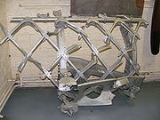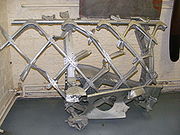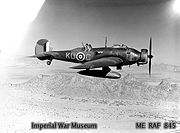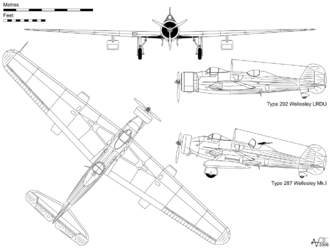
Vickers Wellesley
Encyclopedia
The Vickers Wellesley was a British
United Kingdom
The United Kingdom of Great Britain and Northern IrelandIn the United Kingdom and Dependencies, other languages have been officially recognised as legitimate autochthonous languages under the European Charter for Regional or Minority Languages...
1930s light bomber
Light bomber
A light bomber is a relatively small and fast class of military bomber aircraft which were primarily employed before the 1950s. Such aircraft would typically not carry more than one ton of ordnance....
built by Vickers-Armstrongs at Brooklands
Brooklands
Brooklands was a motor racing circuit and aerodrome built near Weybridge in Surrey, England. It opened in 1907, and was the world's first purpose-built motorsport venue, as well as one of Britain's first airfields...
near Weybridge
Weybridge
Weybridge is a town in the Elmbridge district of Surrey in South East England. It is bounded to the north by the River Thames at the mouth of the River Wey, from which it gets its name...
, Surrey, for the Royal Air Force
Royal Air Force
The Royal Air Force is the aerial warfare service branch of the British Armed Forces. Formed on 1 April 1918, it is the oldest independent air force in the world...
. While it was obsolete by the start of the Second World War
World War II
World War II, or the Second World War , was a global conflict lasting from 1939 to 1945, involving most of the world's nations—including all of the great powers—eventually forming two opposing military alliances: the Allies and the Axis...
, and unsuited to the Europe
Europe
Europe is, by convention, one of the world's seven continents. Comprising the westernmost peninsula of Eurasia, Europe is generally 'divided' from Asia to its east by the watershed divides of the Ural and Caucasus Mountains, the Ural River, the Caspian and Black Seas, and the waterways connecting...
an air war, the Wellesley was successfully used in the desert theatres of East Africa
Africa
Africa is the world's second largest and second most populous continent, after Asia. At about 30.2 million km² including adjacent islands, it covers 6% of the Earth's total surface area and 20.4% of the total land area...
, Egypt
Egypt
Egypt , officially the Arab Republic of Egypt, Arabic: , is a country mainly in North Africa, with the Sinai Peninsula forming a land bridge in Southwest Asia. Egypt is thus a transcontinental country, and a major power in Africa, the Mediterranean Basin, the Middle East and the Muslim world...
and the Middle East
Middle East
The Middle East is a region that encompasses Western Asia and Northern Africa. It is often used as a synonym for Near East, in opposition to Far East...
.
Design and development

Air Ministry
The Air Ministry was a department of the British Government with the responsibility of managing the affairs of the Royal Air Force, that existed from 1918 to 1964...
Specification G.4/31 which called for a general purpose aircraft, capable of carrying out level bombing, army co-operation, dive bombing
Dive bomber
A dive bomber is a bomber aircraft that dives directly at its targets in order to provide greater accuracy for the bomb it drops. Diving towards the target reduces the distance the bomb has to fall, which is the primary factor in determining the accuracy of the drop...
, reconnaissance
Reconnaissance
Reconnaissance is the military term for exploring beyond the area occupied by friendly forces to gain information about enemy forces or features of the environment....
, casualty evacuation and torpedo bombing
Torpedo bomber
A torpedo bomber is a bomber aircraft designed primarily to attack ships with aerial torpedoes which could also carry out conventional bombings. Torpedo bombers existed almost exclusively prior to and during World War II when they were an important element in many famous battles, notably the...
. The Vickers Type 253, which used a radical geodesic airframe construction that was derived from that used by Barnes Wallis
Barnes Wallis
Sir Barnes Neville Wallis, CBE FRS, RDI, FRAeS , was an English scientist, engineer and inventor. He is best known for inventing the bouncing bomb used by the RAF in Operation Chastise to attack the dams of the Ruhr Valley during World War II...
in the airship
Airship
An airship or dirigible is a type of aerostat or "lighter-than-air aircraft" that can be steered and propelled through the air using rudders and propellers or other thrust mechanisms...
R100
R100
HM Airship R100 was a privately designed and built rigid airship made as part of a two-ship competition to develop new techniques for a projected larger commercial airship for use on British empire routes...
, was tested against the specification along with the Fairey G.4/31
Fairey G.4/31
The Fairey G.4/31 was a British single-engined, two-seat biplane contender for an Air Ministry specification for a multi-role or general purpose aircraft. Unsuccessful, only one was built.-Development:...
, Westland PV-7, Handley Page HP.47, Armstrong Whitworth A.W.19, Blackburn B-7, Hawker P.V.4
Hawker P.V.4
-See also:-Bibliography:* Hannah, Donald. Hawker FlyPast Reference Library. Stamford, Lincolnshire, UK: Key Publishing Ltd., 1982. ISBN 0-946219-01-X....
and the Parnall G.4/31
Parnall G.4/31
-References:NotesBibliography* Lewis, Peter. "Parnall G.4/31." Air Pictorial, Volume 25, No. 9, September 1963.* Mason, Francis K. The British Bomber since 1914. London:Putnam, 1994. ISBN 0-85177-861-5....
. The Type 253 was declared the winner, with 150 being ordered.
The Vickers Type 246 monoplane
Monoplane
A monoplane is a fixed-wing aircraft with one main set of wing surfaces, in contrast to a biplane or triplane. Since the late 1930s it has been the most common form for a fixed wing aircraft.-Types of monoplane:...
, which used the same geodetic design principles for both the fuselage and wings, was then built as a private venture, first flown at Brooklands by Chief Test Pilot J "Mutt" Summers, on 19 June 1935 and offered to the RAF. This had superior performance, but did not attempt to meet the multi-role requirements of the specification, being designed as a bomber only. An initial order for 96 Type 246s was substituted for the Type 253 order. The RAF ultimately ordered a total of 176 as the Wellesley, to a newly written specification 22/35, with a 14-month production run starting in March 1937.
The Wellesley was a single-engine monoplane with a very high aspect ratio
Aspect ratio (wing)
In aerodynamics, the aspect ratio of a wing is essentially the ratio of its length to its breadth . A high aspect ratio indicates long, narrow wings, whereas a low aspect ratio indicates short, stubby wings....
wing, and a manually-operated, retractable undercarriage
Undercarriage
The undercarriage or landing gear in aviation, is the structure that supports an aircraft on the ground and allows it to taxi, takeoff and land...
. As it was not known how the geodetic structure could cope with being disrupted by a bomb bay, the Wellesley's bomb load was carried in two streamlined panniers under the wings. The Wellesley Mk I had two separate cockpits, but this was changed in the Wellesley Mk II to a single-piece cockpit canopy covering both the pilot and navigator positions.
Operational history

RAF Bomber Command
RAF Bomber Command controlled the RAF's bomber forces from 1936 to 1968. During World War II the command destroyed a significant proportion of Nazi Germany's industries and many German cities, and in the 1960s stood at the peak of its postwar military power with the V bombers and a supplemental...
squadrons in the UK. Five aircraft with provisions for three crew members were modified for long-range work with the RAF Long-Range Development Flight. Additional modifications included the fitting of Pegasus XXII engines and extra fuel tanks. On 5 November 1938, three of them under command of S/L R. Kellett flew non-stop for two days from Ismailia
Ismaïlia
-Notable natives:*Osman Ahmed Osman, a famous and influential Egyptian engineer, contractor, entrepreneur, and politician, was born in this town on 6 April 1917....
, Egypt
Egypt
Egypt , officially the Arab Republic of Egypt, Arabic: , is a country mainly in North Africa, with the Sinai Peninsula forming a land bridge in Southwest Asia. Egypt is thus a transcontinental country, and a major power in Africa, the Mediterranean Basin, the Middle East and the Muslim world...
to Darwin
Darwin, Northern Territory
Darwin is the capital city of the Northern Territory, Australia. Situated on the Timor Sea, Darwin has a population of 127,500, making it by far the largest and most populated city in the sparsely populated Northern Territory, but the least populous of all Australia's capital cities...
, Australia
Australia
Australia , officially the Commonwealth of Australia, is a country in the Southern Hemisphere comprising the mainland of the Australian continent, the island of Tasmania, and numerous smaller islands in the Indian and Pacific Oceans. It is the world's sixth-largest country by total area...
(7,162 mi/11,525 km) setting a world distance record
Flight distance record
-Non-commercial powered aircraft:-Commercial aircraft:-Other types of aircraft:-References:* Mikesh, Robert C. and Abe, Shorzoe. Japanese Aircraft 1910-1941. London:Putnam, 1990. ISBN 0-85177-840-2....
. All three aircraft succeeded in breaking the existing record, but No. 2 aircraft landed in West Timor, 500 mi (800 km) short of the final objective. The Wellesley's record remained unbroken until November 1945. To this day, though, this flight remains the longest by a single engined aircraft.
By the outbreak of the Second World War
World War II
World War II, or the Second World War , was a global conflict lasting from 1939 to 1945, involving most of the world's nations—including all of the great powers—eventually forming two opposing military alliances: the Allies and the Axis...
, the Wellesley had been phased out from home based squadrons, with only four examples remaining in Britain, but remained in service with three squadrons based in the Middle East. Following the Italian declaration of war on 10 June 1940, the remaining Wellesley squadrons became involved in the East African Campaign
East African Campaign (World War II)
The East African Campaign was a series of battles fought in East Africa during World War II by the British Empire, the British Commonwealth of Nations and several allies against the forces of Italy from June 1940 to November 1941....
against Italian forces in Eritrea, Ethiopia, and Somaliland
Italian East Africa
Italian East Africa was an Italian colonial administrative subdivision established in 1936, resulting from the merger of the Ethiopian Empire with the old colonies of Italian Somaliland and Italian Eritrea. In August 1940, British Somaliland was conquered and annexed to Italian East Africa...
.
Sudan-based Wellesleys carried out their first bombing mission on 11 June 1940 against Asmara
Asmara
Asmara is the capital city and largest settlement in Eritrea, home to a population of around 579,000 people...
in Eritrea. Although obsolete, the Wellesley formed a major part of the British Commonwealth's available bomber forces, mainly carrying out raids against Eritrea and Northern Ethiopia. In the early part of the campaign, fighter escort was not available, and when caught by Fiat CR.42
Fiat CR.42
The Fiat CR.42 Falco was a single-seat sesquiplane fighter which served primarily in Italy's Regia Aeronautica before and during World War II. The aircraft was produced by the Turin firm, and entered service, in smaller numbers, with the air forces of Belgium, Sweden and Hungary...
s, proved vulnerable to the Italian biplane fighter. Despite this, the Wellesley continued to be used for bombing raids, bombing Addis Ababa
Addis Ababa
Addis Ababa is the capital city of Ethiopia...
from Aden
Aden
Aden is a seaport city in Yemen, located by the eastern approach to the Red Sea , some 170 kilometres east of Bab-el-Mandeb. Its population is approximately 800,000. Aden's ancient, natural harbour lies in the crater of an extinct volcano which now forms a peninsula, joined to the mainland by a...
on 18 August. The Wellesley continued in use against the Italians over East Africa until November 1941, when Gondar
Gondar
Gondar or Gonder is a city in Ethiopia, which was once the old imperial capital and capital of the historic Begemder Province. As a result, the old province of Begemder is sometimes referred to as Gondar...
, the last Italian-held town, fell to Commonwealth and Ethiopian forces. The final Wellesley equipped unit, 47 Squadron
No. 47 Squadron RAF
No. 47 Squadron of the Royal Air Force operates the Hercules from RAF Brize Norton, Oxfordshire.-First formation:No. 47 Squadron Royal Flying Corps was formed at Beverley, East Riding of Yorkshire on 1 March 1916 as a home defence unit, protecting Hull and East Yorkshire against attack by German...
was then switched to carrying out maritime reconnaissance duties over the Red Sea
Red Sea
The Red Sea is a seawater inlet of the Indian Ocean, lying between Africa and Asia. The connection to the ocean is in the south through the Bab el Mandeb strait and the Gulf of Aden. In the north, there is the Sinai Peninsula, the Gulf of Aqaba, and the Gulf of Suez...
, continuing in this role until September 1942.
While the Wellesley was not a significant combat aircraft, the design principles that were tested in its construction were put to good use with the Wellington
Vickers Wellington
The Vickers Wellington was a British twin-engine, long range medium bomber designed in the mid-1930s at Brooklands in Weybridge, Surrey, by Vickers-Armstrongs' Chief Designer, R. K. Pierson. It was widely used as a night bomber in the early years of the Second World War, before being displaced as a...
medium bomber
Medium bomber
A medium bomber is a bomber aircraft designed to operate with medium bombloads over medium distances; the name serves to distinguish them from the larger heavy bombers and smaller light bombers...
that became one of the main types of Bomber Command in the early years of the European war.
In February 1940, three Wellesleys (K7728, K7735 and K8531) were sold to Egypt to serve in the Royal Egyptian Air Force
Egyptian Air Force
The Egyptian Air Force, or EAF , is the aviation branch of the Egyptian Armed Forces. The EAF is headed by an Air Marshal . Currently, the commander of the Egyptian Air Force is Air Marshal Reda Mahmoud Hafez Mohamed...
.
Variants
Type 281 Wellesley- Company designation for the Wellesley bomber.
Type 287 Wellesley Mk I
- Two-seat medium bomber aircraft. The Wellesley Mk I had two separate cockpits.
Wellesley Mk II
- The Mk II had a single-piece cockpit canopy.
Type 289
- Engine testbed. It was used to test the Hercules HE15Bristol Hercules|-See also:-Bibliography:*Gunston, B. Classic World War II Aircraft Cutaways. Osprey. ISBN 1-85532-526-8*Gunston, Bill. World Encyclopedia of Aero Engines. Cambridge, England. Patrick Stephens Limited, 1989. ISBN 1-85260-163-9...
radial piston engine.
Type 291
- Blind-flying model.
Type 292
- Three aircraft were modified for long-distance flying. The aircraft were used by the RAF's Long-Range Development Flight.
Type 294
- Prototype with strengthened wing.
Type 402
- Three-seat experimental aircraft.
Operators
 South Africa
South Africa
- South African Air ForceSouth African Air ForceThe South African Air Force is the air force of South Africa, with headquarters in Pretoria. It is the world's second oldest independent air force, and its motto is Per Aspera Ad Astra...
- Royal Air ForceRoyal Air ForceThe Royal Air Force is the aerial warfare service branch of the British Armed Forces. Formed on 1 April 1918, it is the oldest independent air force in the world...
- No. 7 Squadron RAFNo. 7 Squadron RAFNo. 7 Squadron of the Royal Air Force operates the Boeing Chinook HC.2 from RAF Odiham, Hampshire.-Formation and early years:No. 7 Squadron was formed at Farnborough Airfield on 1 May 1914 as the last squadron of the RFC to be formed before the First World War, but has been disbanded and reformed...
- No. 14 Squadron RAFNo. 14 Squadron RAFNo. 14 Squadron of the Royal Air Force currently operates the Beechcraft Shadow R1 in the ISTAR role from RAF Waddington.-World War I:...
- No. 35 Squadron RAF
- No. 45 Squadron RAFNo. 45 Squadron RAF-First World War:Formed during World War I at Gosport on 1 March 1916 as Number 45 Squadron, the unit was first equipped with Sopwith 1½ Strutters which it was to fly in the Scout role. Deployed to France in October of that year, the Squadron found itself suffering heavy losses due to the quality...
- No. 47 Squadron RAFNo. 47 Squadron RAFNo. 47 Squadron of the Royal Air Force operates the Hercules from RAF Brize Norton, Oxfordshire.-First formation:No. 47 Squadron Royal Flying Corps was formed at Beverley, East Riding of Yorkshire on 1 March 1916 as a home defence unit, protecting Hull and East Yorkshire against attack by German...
- No. 76 Squadron RAFNo. 76 Squadron RAFNo. 76 Squadron is a squadron of the Royal Air Force. It was formed during World War I as a home defence fighter squadron and in its second incarnation during World War II flew as a bomber squadron, first as an operational training unit and later as an active bomber squadron...
- No. 77 Squadron RAFNo. 77 Squadron RAFNo. 77 Squadron RAF was formed on 1 October 1916 at Edinburgh, and was equipped with B.E.2 and B.E.12 aircraft. The squadron disbanded at RAF Turnhouse on June 13, 1919....
- No. 117 Squadron RAFNo. 117 Squadron RAFNo. 117 Squadron RAF was a Royal Air Force Squadron formed to be a bomber unit in World War I and reformed as a transport and communications unit in World War II.-Formation and World War I:...
- No. 148 Squadron RAFNo. 148 Squadron RAFNo. 148 Squadron of the Royal Air Force has been part of the RAF since World War I.-History:As No. 148 Squadron it was reformed as a special duties squadron and part of the Balkan Air Force in World War II. It dropped men and materiel behind enemy lines in the occupied countries such as...
- No. 207 Squadron RAF
- No. 223 Squadron RAFNo. 223 Squadron RAFNo. 223 Squadron RAF was a squadron of the Royal Air Force. Originally formed as part of the Royal Naval Air Service , the Squadron flew in both World Wars.-History:...
- No. 267 Squadron RAFNo. 267 Squadron RAFNo. 267 Squadron RAF was a unit of the Royal Air Force that served during World War I & World War II. The squadron has been formed a total of four times.The squadron was formed at RAF Kalafrana, Malta on 27 September 1918 from Nos...
- No. 7 Squadron RAF
Specifications (Wellesley)


